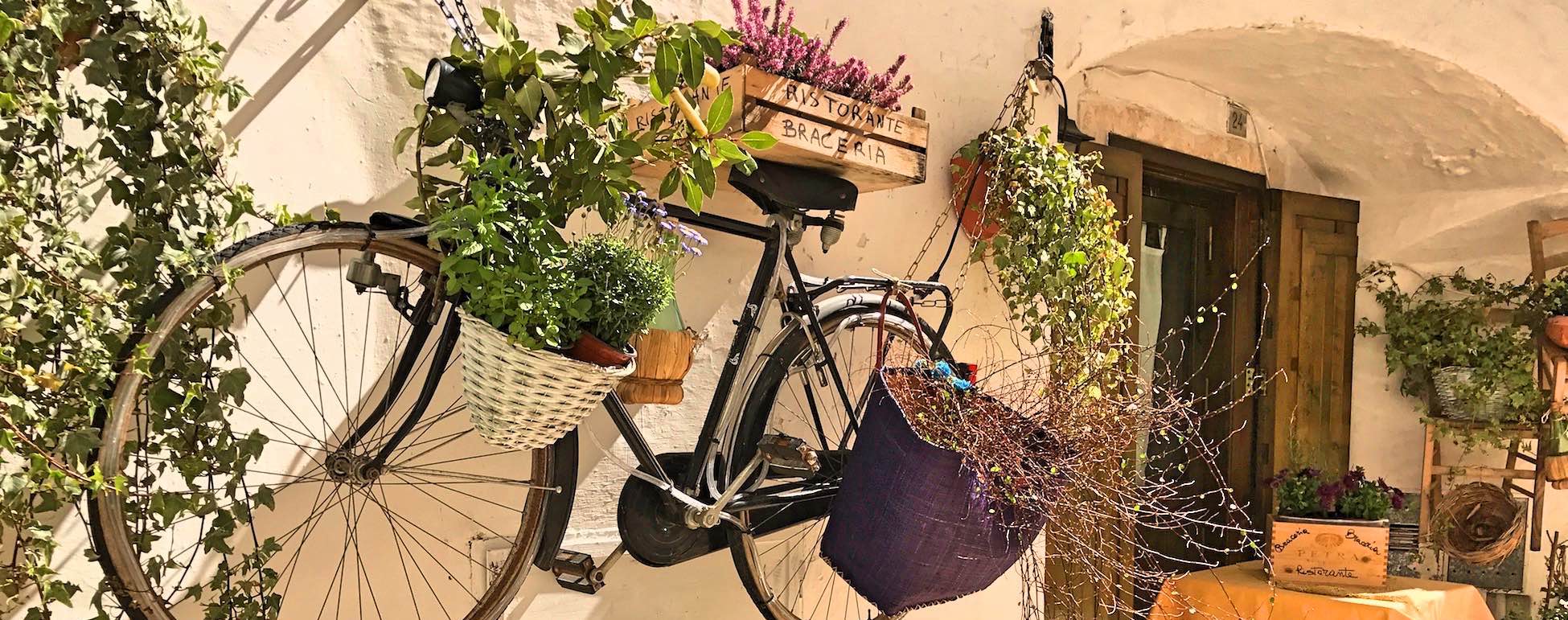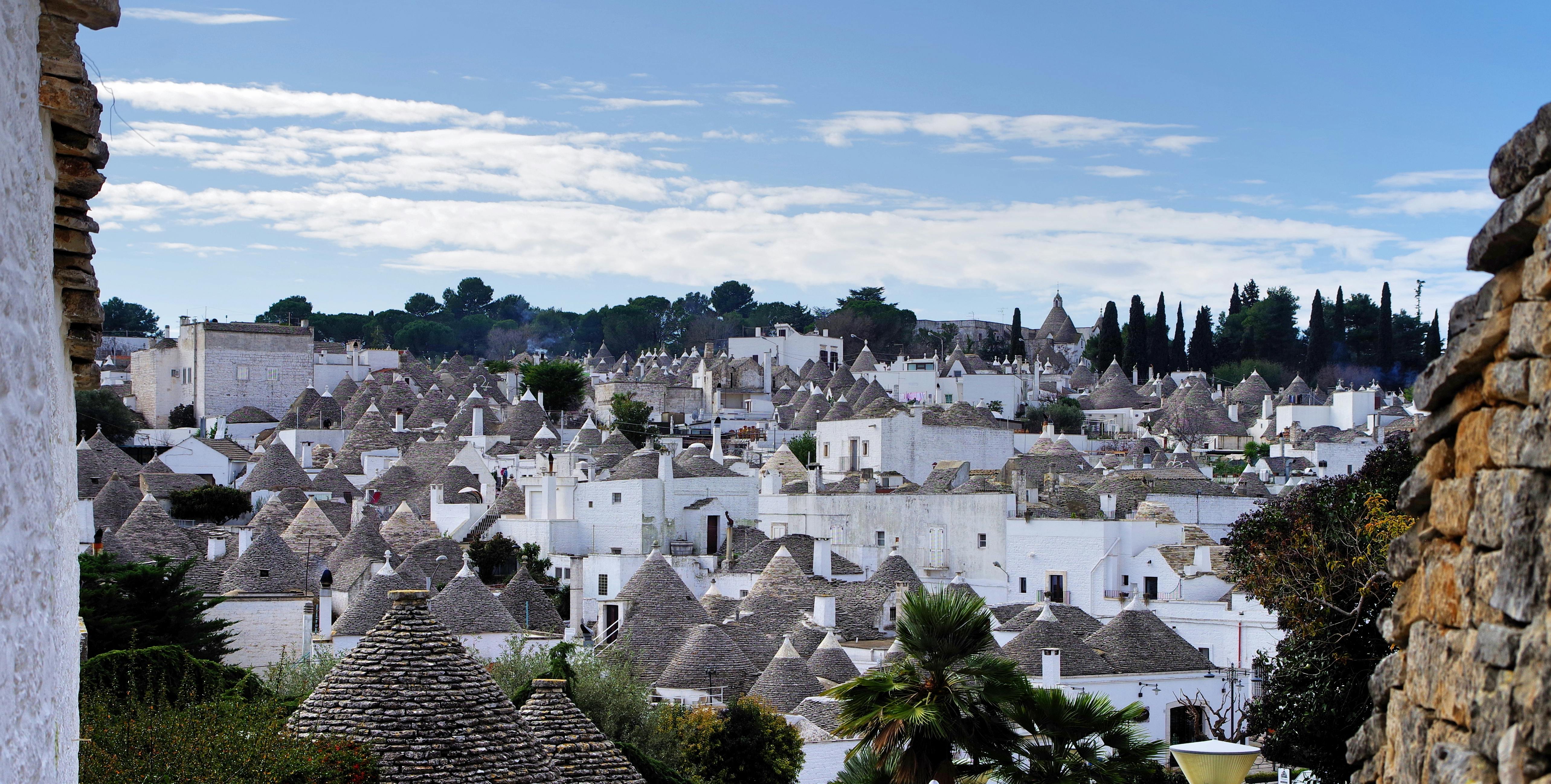The beautiful season is approaching and there are many spring weekends that we can take advantage of for a short bike trip. I think back to a trip I took in November but which, considering the mild temperatures of the spring months, could very well be replicated in the following months too.
I wanted to cycle in Puglia and look around in areas that I didn't know very well, namely the Murgia dei Trulli, and also to do some gentle ups and downs with the bike. The evening before, taking advantage of the possibility of leaving Lecce with the regional train and bringing my bike with me, I stayed overnight in Monopoli, partly to leave already there and partly because I always like the city a lot, both in summer and in winter; the castle on the sea, the small port, the many streets full of life, I would say they are a really nice starting point.

1. Monopoli - Polignano - Conversano
In the morning after a hearty breakfast, we start pedalling, keeping the sea on the right, towards Polignano (you decide whether it is better known for the spectacular dives of Red Bull Cliff Diving or for being the birthplace of Domenico Modugno). Before arriving in the historic centre we make an interesting stop at the Pino Pascali Foundation, which traces the life and various creative phases of the artist. After all, Puglia is not just papier-mâché, gastronomy or the sea: if you look carefully it is also a lot of modernity, political struggles and different artistic languages.
Slowly, on the pedestrian path that runs alongside the seafront, we arrive in the heart of the historic centre. Turning in the narrow streets always full of people is almost impossible and so we park them in the square immediately after the entrance to the main door to look out onto the promontory (I think one of the most famous in Italy) and see the sea crash on the rocky spur. Those who live in these houses, I think, cannot have the sea because they practically live on the water. Waving goodbye to the sea we begin to climb the Murgia in front of us, leaving the town behind us. Turning your eyes left and right you immediately notice this sort of small panettone that interrupts the monotony of the board. The name Murgia itself derives from "murex", and in fact indicates the terraced plateau, composed of remains sedimented in the chorus of millennia of mollusc shells, like a real step, characterised by compact limestones rich in karst phenomena which slowly they then slope towards the plain between Taranto and Lecce .
The landscape changes
The olive trees are starting to make way for fruit trees, few but certainly more numerous in the past, and oaks, and looking at the dry stone walls that delimit the countryside and the properties, the words of those who had defined this ingenious dry architecture as << one of the most sensational manifestations of the peasant ability to bend one of the most impervious and repulsive fragments of the Apulian stony ground to their own productive purposes, through a spirit of initiative and a large profusion of work >> in other words the spirit of adaptation – or “resilience” as many would say today – of the “people of ants” that Tommaso Fiore spoke about. We go up zigzagging between the dry stone walls towards Conversano. The countryside is actually very beautiful, very lived in and cultivated. Living in Salento I often forget how beautiful and colourful a plot of land close to a farm can be. Down here, if they haven't been abandoned, they have become resorts with English grass. Here, however, the land is still at the centre of the economic and social life of the area. Incredulously amazing and stunning!
We arrive in Conversano and we are immediately struck by the Norman castle placed in a controlling position on the highest point of the town, testimony to the glorious feudal past when the county of Conversano was one of the most important in all of Puglia, passed from hand to hand between the families best known and most important in all of southern Italy. Before finding a place to drink a nice cold beer and refresh ourselves, let's take a short tour of the town. The streets are beautiful, clean, well maintained, with colourful flowers in the flowerbeds, and small craft shops. We like it! We dedicate our time to visiting the cathedral, in Apulian Romanesque style, truly surprising for a town of its relative size. Here too, as happens throughout Italy, a large cathedral in the centre of the town indicates an important part of the city, when temporal power and spiritual power coexisted within the perimeter of a church.

2. Conversano - Castellana Grotte - Putignano - Noci
The countryside is the undisputed queen of this stage: the alternation of vineyards, olive groves and remnants of woods, together with the presence of a dense network of dry stone walls create the agricultural mosaic of this area. The farms, still very lived in and very productive, hold in their hands the witness of what was the rich land ownership of the past and in the districts you never feel alone: they are full of hard-working farmers with whom it is nice to greet and chat. We treat ourselves to a quick coffee break in the centre of Castellana (in reality, those who have never visited them can make a longer stop to see the famous Caves (3348 metres long, 122 metres deep and with an internal temperature of around 16.5°C ) The next stop is Putignano, famous in Puglia for its long-lived carnival, but with a lively and colourful historic centre. From Putignano to Noci the road is almost a straight line, you can almost glimpse the destination, but the perspective is quite deceptive, given that we descend brutally and ascend equally brutally. We face the climb in the belief that a beer upon arrival is undoubtedly deserved! Noci also has a very beautiful historic centre, characterised by the "Gnostre" (from claustrum , cloister), which are not nothing more than small atriums overlooked by the surrounding houses; originally they were actual streets, then closed to make room for new houses following the population increase of the 18th century, effectively cutting off the road system and thus creating these spaces that they are semi-public and semi-private at the same time.
3. Noci - Alberobello - Fasano
Today's first stop, a few km from Noci, is the Church of Santa Maria del Barsento, which has become one of the most iconic places in the entire Itria Valley. This abbey is a synthesis of all the historical and cultural stratifications of the area. Already inhabited since the Bronze Age, thanks to its strategic position between the Ionian and Adriatic roads and subsequently by the Messapi people, who gave it the name "barza" (high) and "entum" (i.e. "place placed in alto”), in fact this church enjoys an enviable position, located on a promontory that dominates the entire so-called Pirro canal, so much so that even the Romans made it their outpost. The Byzantines also inhabited this place, as demonstrated by various coins found, and the frescoes on the walls, followed by a monastic community in the Middle Ages (the Barsentani clerics) around which a sizable rural community developed, creating a real farmhouse. At present it is a church of strong Romanesque style, but with architecture that recalls the trulli and inside a Byzantine spirit. But above all it has an unparalleled view of the plain of olive trees that go towards the Adriatic Sea!!
If you don't know the Barsento church you are not a true cyclist because it is one of the most loved and well-known destinations for those who travel by bike. Having said goodbye to this white lime church, we aim for another place that cannot be more iconic: Alberobello. A UNESCO site since 1996 and made famous by its almost 1500 trulli (technically defined as "spontaneous architecture") is one of the super tourist destinations in Puglia. To avoid feeling swallowed up by mass tourism, it is best to get off your bike and take a walk in the Aia Piccola district - for exclusive residential use without bars, restaurants and souvenir shops - and enter some trullo to experience the rural life of the time. Alberobello does not have as ancient a history as one might think; the town as we can admire it today was actually born only at the end of the 14th century by will of the Counts of Conversano, landowners who entrusted the management of the territory to some farmers. Since the law of the Kingdom of Naples provided for the payment of a tribute for each new village built, the farmers devised a small stratagem to avoid paying those taxes: building small temporary shelters - for people, tools and animals - easy to build and equally easy to demolish in case of inspections. After an initial settlement of around 40 trulli, in 1620 there was a major expansion.
Only in 1797 was Alberobello freed from all tax demands and feudal servitude by decision of the King of Naples. But the tradition of the trulli, as is evident, has never been interrupted, so much so that we now have this unique and fairy-tale architecture in the heart of Puglia. We leave Alberobello and begin to descend towards Fasano, passing through Coreggia, to then make a stop in San Marco. Small, tree-lined with a small and useful rest area, with a public fountain, a bar and a minimarket, for me it remains one of the undisputed stops in the entire Itria valley! Once we reach the town of Laureto we take the old road to Fasano, where we then take the train to Lecce.
Three beautiful days, where the departure and arrival stations are easily reachable by regional train which allows us to get on board with the bicycle, and which allows us a full immersion in nature, history and art just a stone's throw from home!
To be done again in any month of the year and also varying the duration as desired, perhaps adding other nearby towns, such as Ostuni, Locorotondo, Ceglie etc.
Written by Daniela Scianaro.
For further insight, you can read the original Daniela Scianaro's article here.





